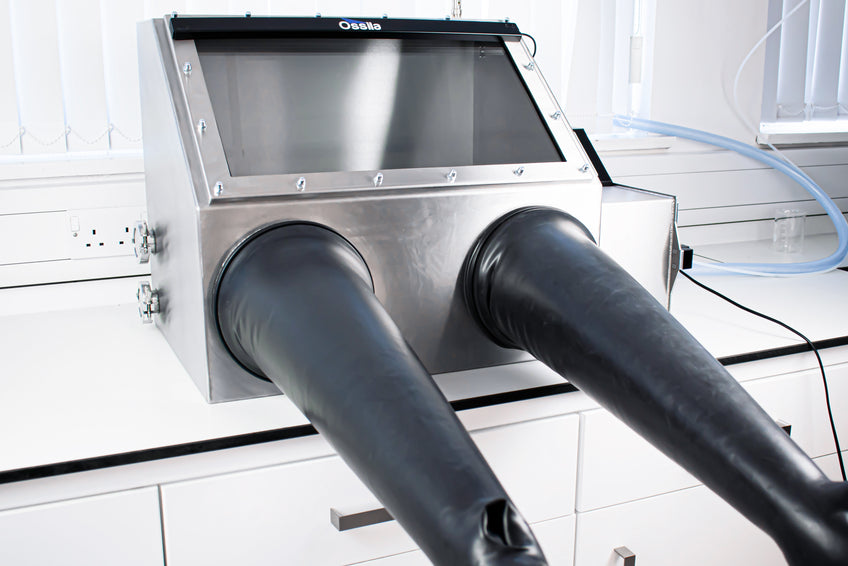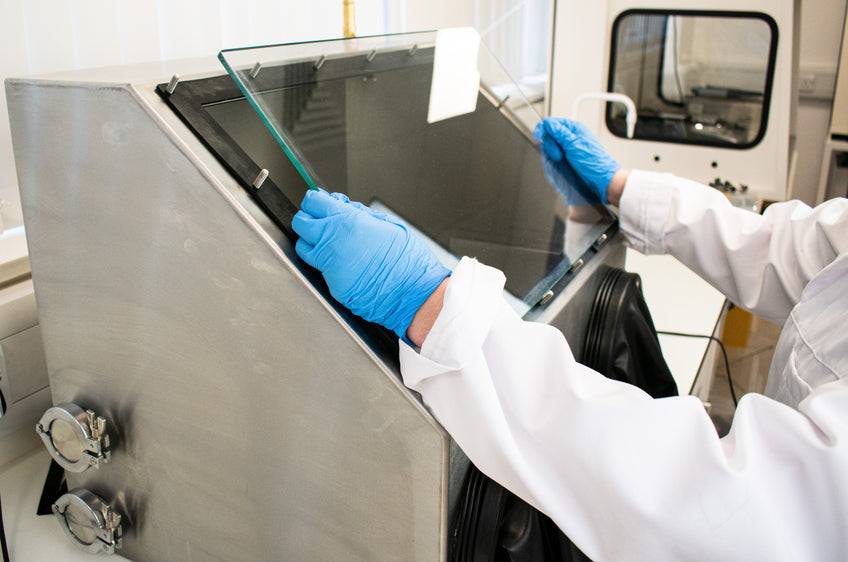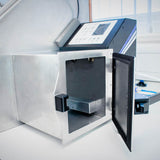How to Choose a Laboratory Glove Box

When buying a glove box, it is important that you choose the most suitable system for your samples, experimental needs, budget, and lab environment. There are lots of different types of glove box and they span orders of magnitude in price, so the first question that you should be asking yourself when you are looking to buy one is what do I need?

Isolation or Contamination Glove Box?
One simple distinction to make early on in your decision-making process is why you need an inert environment. Are you protecting yourself from your sample? Or are you protecting your sample from ambient conditions?
If you are working with very hazardous or nuclear materials, you will need a contamination glove box. These are kept at a negative pressure to ensure that nothing is able to leak outwards from the glove box. Contamination glove boxes are also used in biological applications to protect the user from exposure to biohazardous material.
If you are using an inert environment to protect air-sensitive samples, then you will need an isolation glove box. Isolation glove boxes are held at positive pressure relative to their environment. This means that the inside atmosphere will leak outward if the glove box becomes compromised. These glove boxes prioritise the protection of sensitive samples and ensure that a dry, low-oxygen atmosphere is always maintained inside the glove box.
Inert atmosphere isolation glove boxes create an environment that is completely isolated from the external atmosphere by filling the main chamber with an inert gas, usually nitrogen or argon. This is known as purging. Once the glove box has displaced all the air in the system with the inert gas, the main chamber is sealed. The glove box maintains an overpressure to ensure that no gasses leak into the system. This type of glove box is sometimes referred to as an argon or nitrogen glove box.
The Ossila Glove Box should be used as an isolation glove box. This is because it can quickly achieve low levels of moisture and oxygen within its chambers and can sustain this inert environment long-term. It is therefore ideal for storing and working with air-sensitive materials.
Glove Box Price and Running Costs
Cost is always a key factor when choosing any laboratory equipment. When selecting a glove box, this decision will come down to a balance between the qualities you want in your glove box vs. the budget you have. No matter what your budget, it's important to ensure that you are getting good value for your money.
The cost of a glove box will vary depending on its size. Generally, larger glove boxes are more expensive. Additionally, the larger your glove box, the more inert gas you will need to create an inert atmosphere, which may increase your running costs. More compact glove boxes, like the Ossila Glove Box, have lower initial and maintenance costs.
Large glove boxes also require filtration and purification systems to reduce inert gas consumption. Glove boxes with complex filtration systems come with more significant set up costs and will generally require more significant maintenance. These systems can achieve extremely low levels of moisture and oxygen, and this will be reflected in the price tag. Simpler purging systems tend to have lower setup costs and smaller internal dimensions.
Our lab glove box is a smart choice for those getting started with inert atmosphere processing. We have optimised the design of the glove box to provide a high-quality inert atmosphere using some of the lowest ingression materials, while maintaining low costs (including both the initial price and ongoing running costs).
Levels of Inertness
Different glove boxes will be able to achieve different levels of inertness. The achievable level of inertness may depend on:
- The materials used for glove box construction
- The purity (or impurity) of inert gas used
- If any filtration or purification systems are utilized in the system
- How the gas is purged through or circulated around the system
Some glove boxes can achieve moisture and oxygen levels of <0.1 ppm (parts per million). These glove boxes are necessary for experiments or materials that require extremely low contamination levels. More affordable options like the Ossila Glove Box, however, can also maintain high levels of inertness at <0.5% O2 percentage and <0.1% relative humidity level. This level also makes it suitable for lots of air sensitive experiments.

Although our glove box cannot achieve the same level of inertness as some of the more expensive systems, we've shown that you can still use it to make impressive perovskite solar cells. As well as this, we aged a rubrene film (which undergoes photo-oxidation within 1 hour of exposure to air) in both a 0.1 ppm glove box and in our glove box. We found no observable difference in the film quality of either film, even after weeks of storage in either glove box. This begs the question of which level of inertness your experiment actually needs, and is it worth paying the extra price for?
Glove Box Materials
The materials used in a glove box will influence its achievable level of inertness and also, its cost. Different glove box materials are suitable for different uses - so the material you need will depend on your own glove box criteria.
Some polymer glove boxes (such as those made of disposable plastic glove boxes or "glove bags") will temporarily shield samples from ambient conditions and external drafts over short periods of time. These can be useful if you are preparing samples outside of your lab environment (for example, at an external facility). More sturdy polymer glove boxes (such as PVC alternatives) can offer 360° transparency and are fairly light weight while sustaining a reasonable level of inertness. However, there can still be significant levels of ingression through the polymer walls or seals, and the lifetime of these glove boxes will be limited.
Stainless steel is often used for glove box walls, while glass is used to provide a window into the main chamber. These materials have much lower rates of ingression for both oxygen and moisture than their plastic alternatives. The most expensive isolation glove boxes (as well as the Ossila Glove Box) use stainless steel and hardened glass for their glove box walls to reduce ingression to negligible levels.

Our lab glove box is made up of a grade 304 stainless steel framework and has a hardened glass window. These materials have very little moisture ingression, and the walls are welded together to prevent leakage. The window is bolted into place using sixteen bolts and a tight seal is created using a foam gasket. The system is still small enough so that it is still relatively light-weight. This means it can be placed on any lab bench with little structural impact, and you can even take it with you in the back of a car or a van to conduct experiments elsewhere.
Dimensions
Lab space is a limited and precious resource within most research groups. When choosing a glove box, it is vital to assess how much lab space you want (or have) to dedicate to it.
If you require a large amount of heavy processing within an inert environment, a larger glove box may be the better option for you. This is also the case if you will be having multiple people use the glove box at once. However, increased glove box dimensions come with a hefty price tag, both in terms of installation and running costs.
Smaller glove boxes can be a better choice if you are restricted by space or budget. They can also reach an inert environment quicker than larger glove boxes can.
The Ossila Glove Box can create and sustain a low-oxygen and low-moisture environment with a compact lab footprint. This glove box can be set up on any lab bench and can even be transported between labs due to its small frame and lightweight material. However, there is still more than enough room within the main chamber for a user to conduct experiments.
Does your Glove Box Have the Right Safety Features?
One of the most important things to ensure when using a glove box is that all users are safe. This is especially important when working with hazardous samples such as pyrophoric or nuclear materials. For example, if you are working with samples that emit nuclear radiation, the materials you use need to provide significant protection from radiation exposure. For this, you can get lead lined glove boxes where you can handle nuclear materials.
The necessary safety precautions should be defined for your experiment before purchasing a glove box, and you should discuss any requirements with the manufacturer. The Ossila Glove Box meets all the necessary requirements for working with chemicals in an inert environment. However, if you have any questions about whether our glove box would be suitable for your application, please get in contact with us, and our technical support team would be happy to advise you.
Glove Box

Learn More
 Why Buy the Ossila Glove Box
Why Buy the Ossila Glove Box
Glove boxes are important within many areas of research, including photovoltaics, OFETs, OLEDs and batteries research. They provide the inert atmosphere needed to handle air sensitive compounds, and enough space to conduct a range of experiments.
Read more...